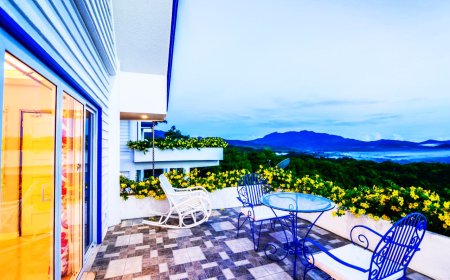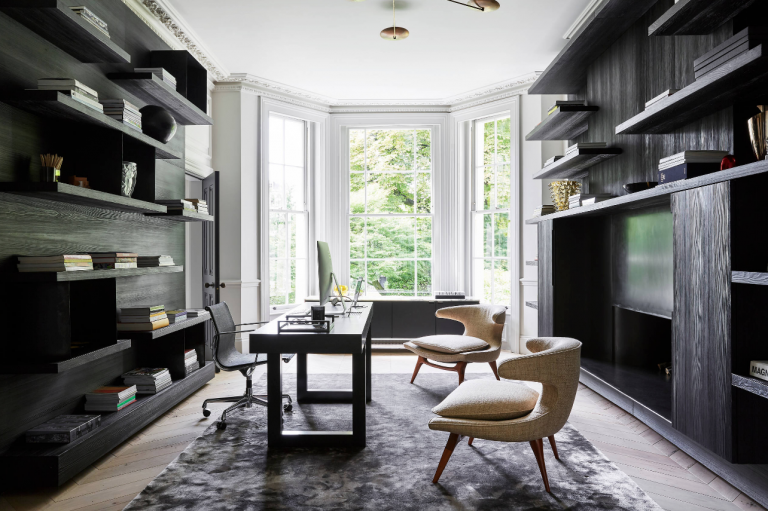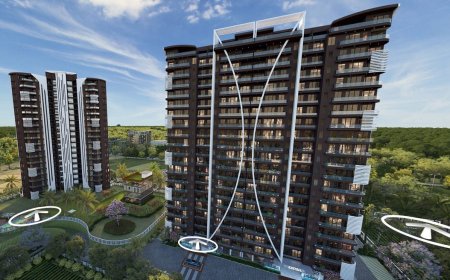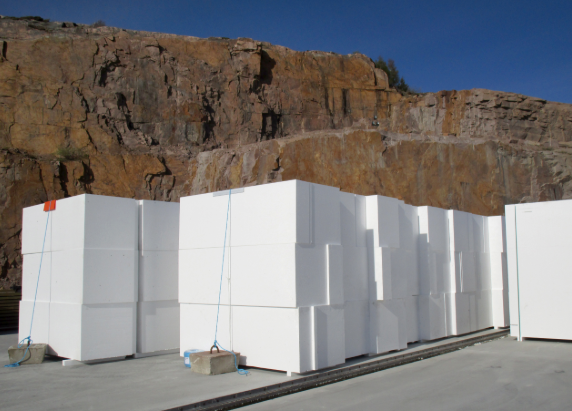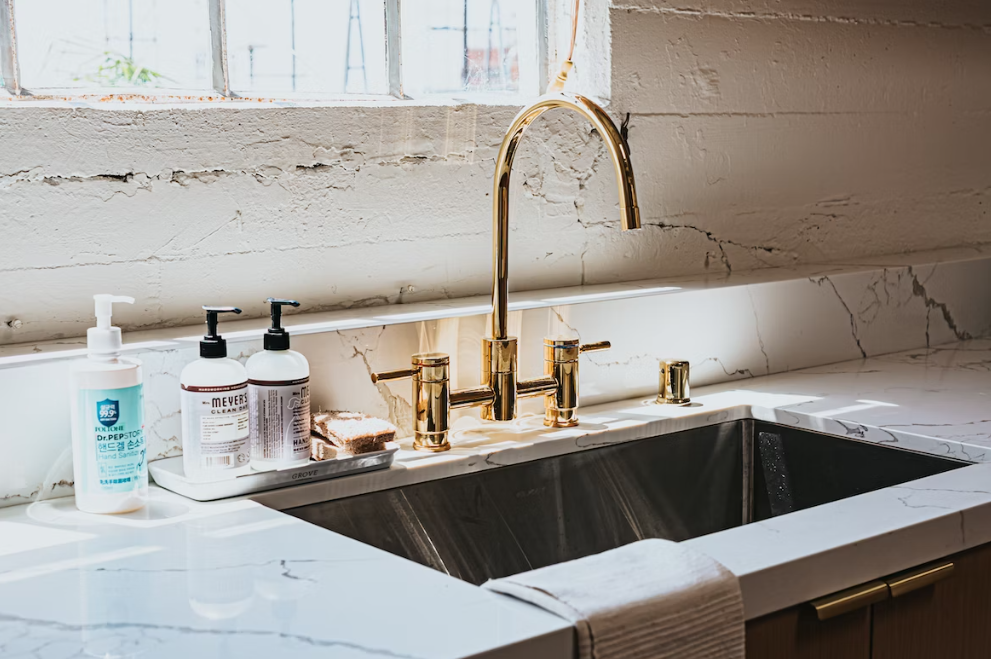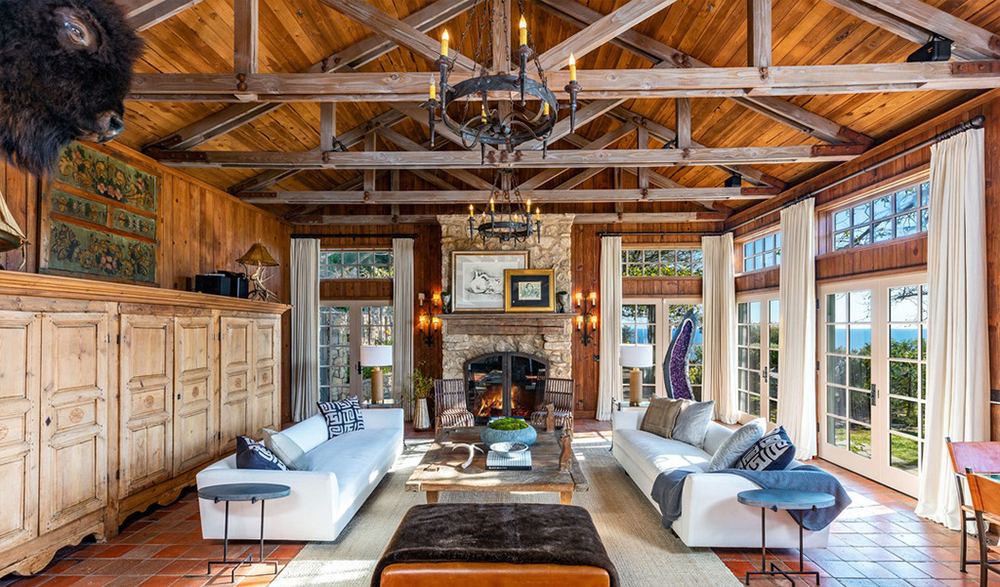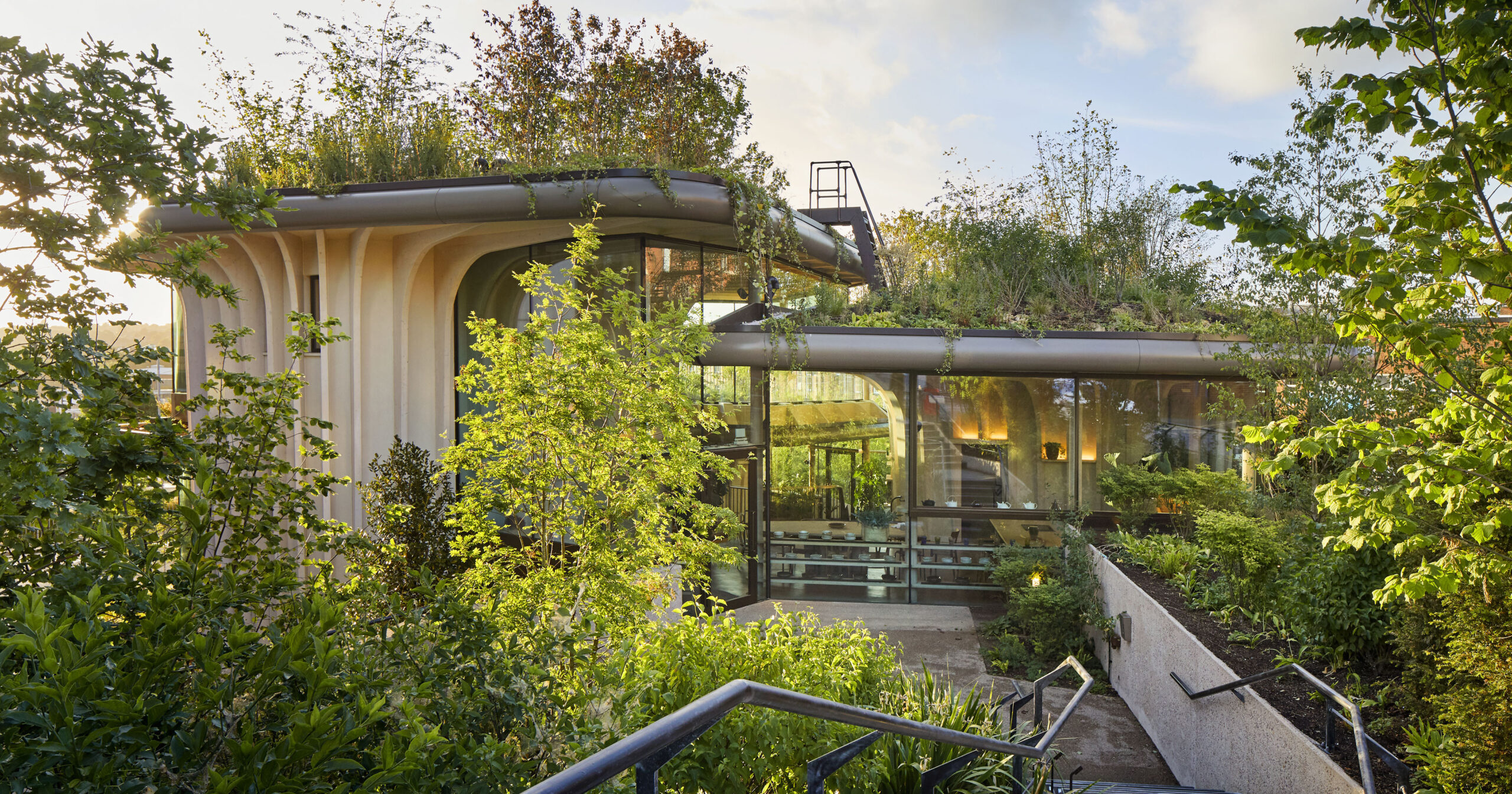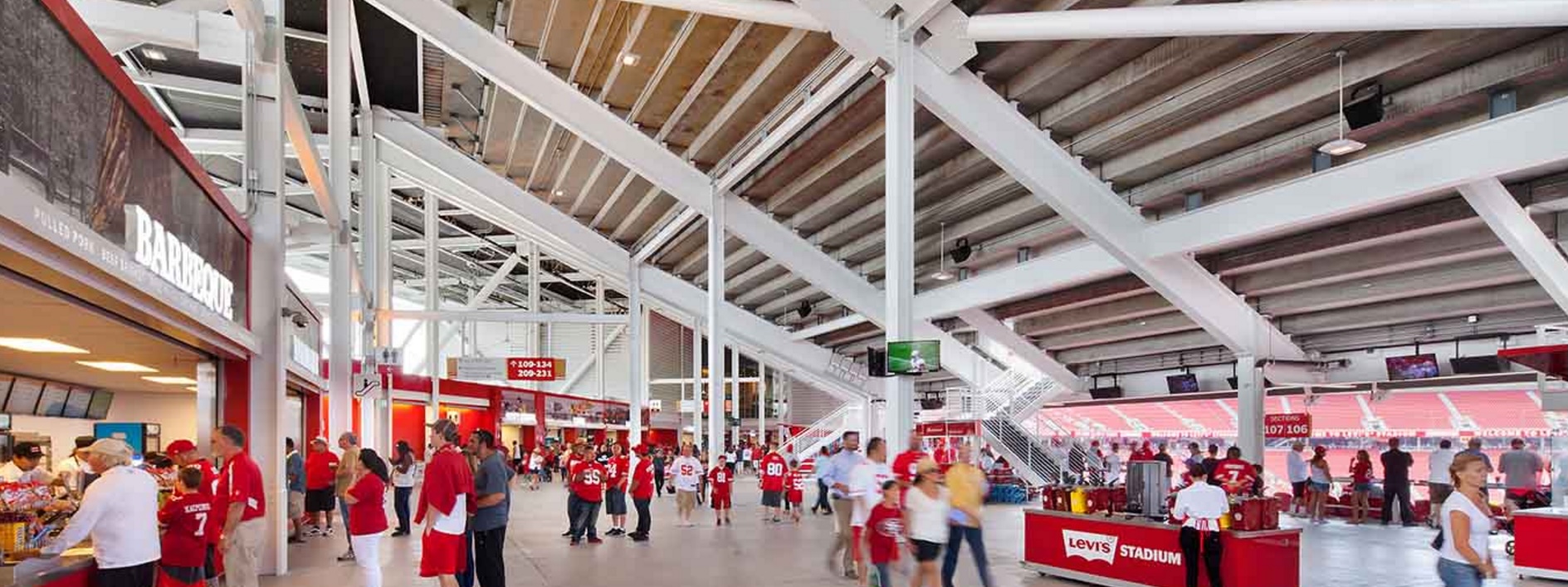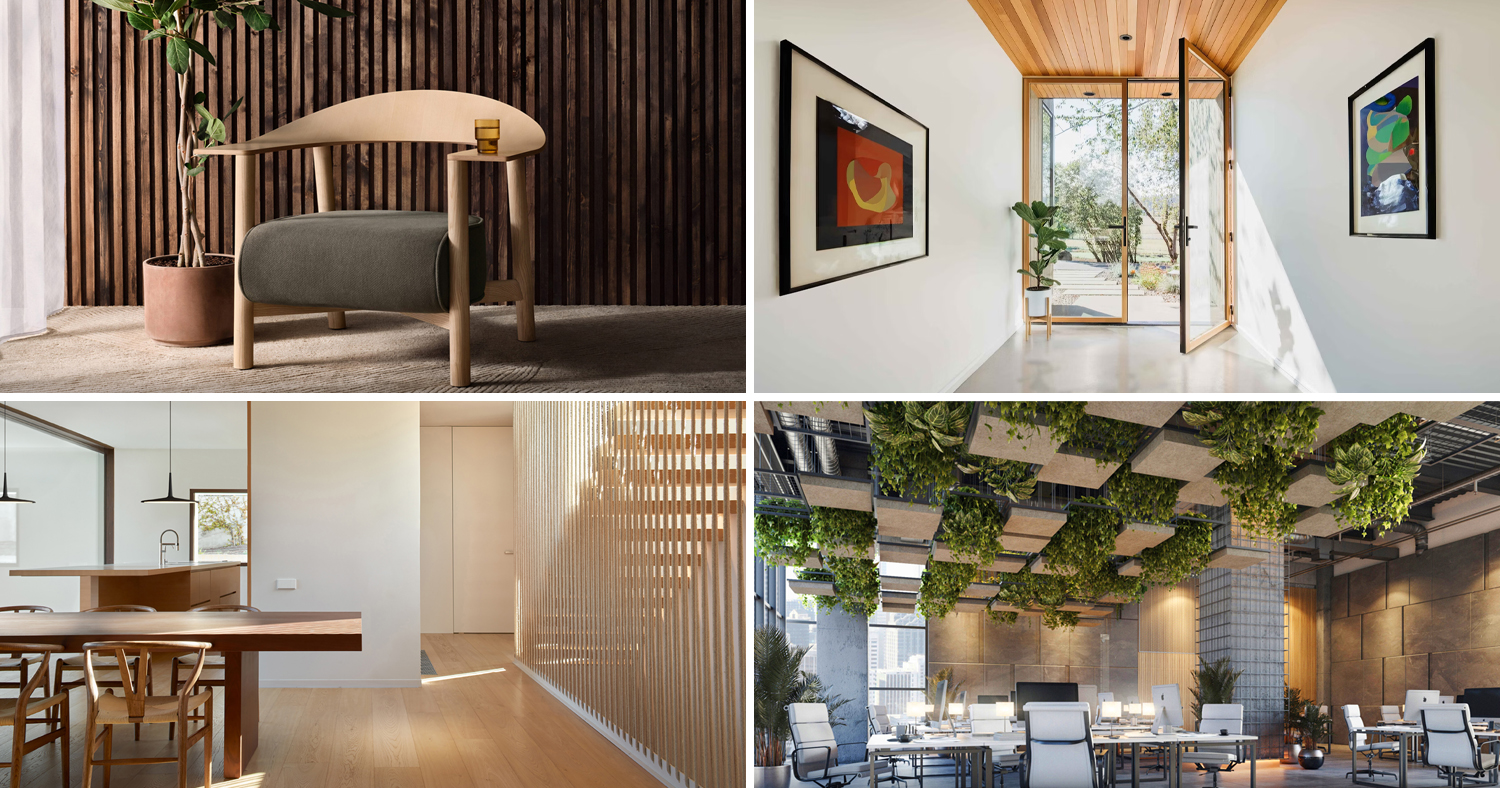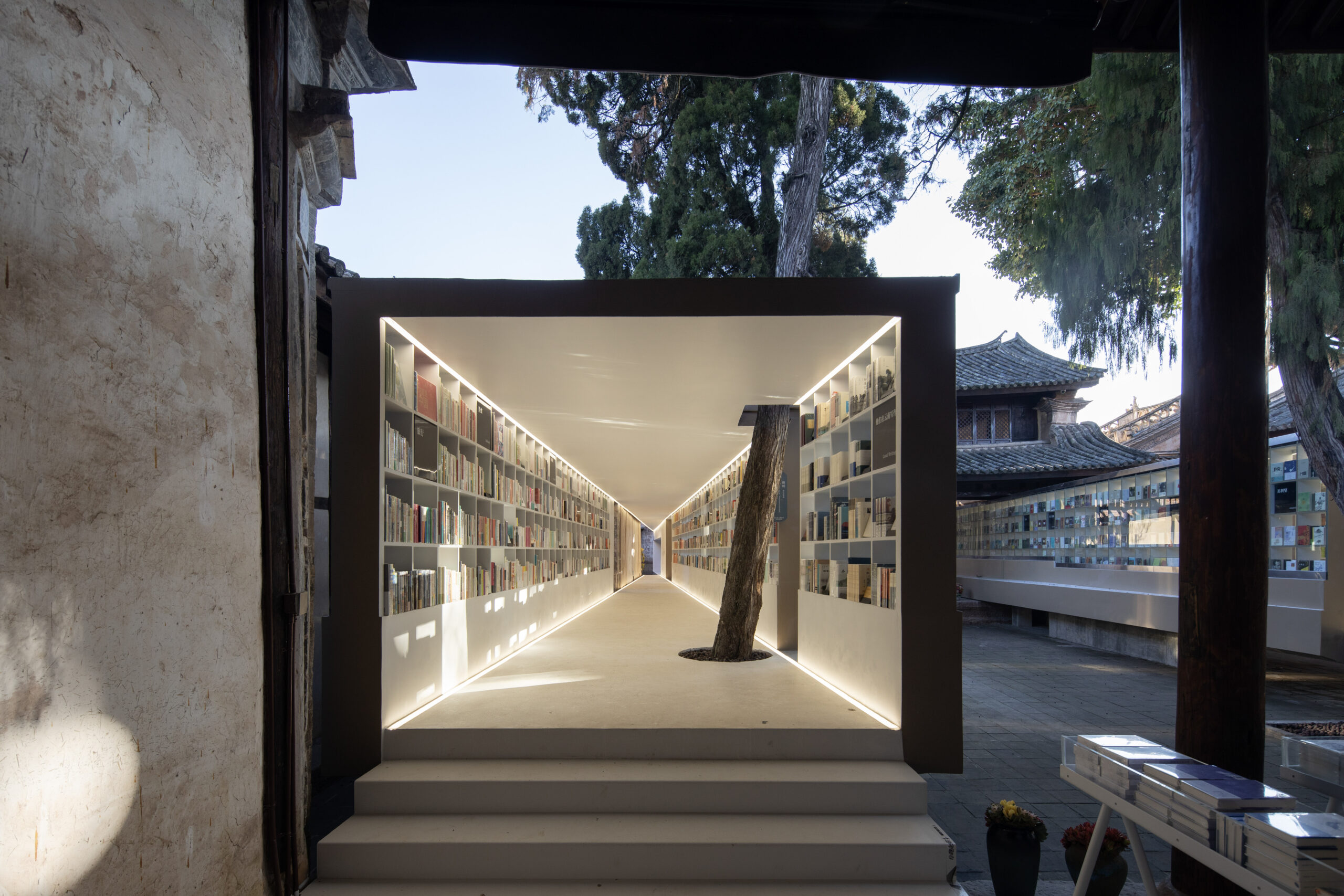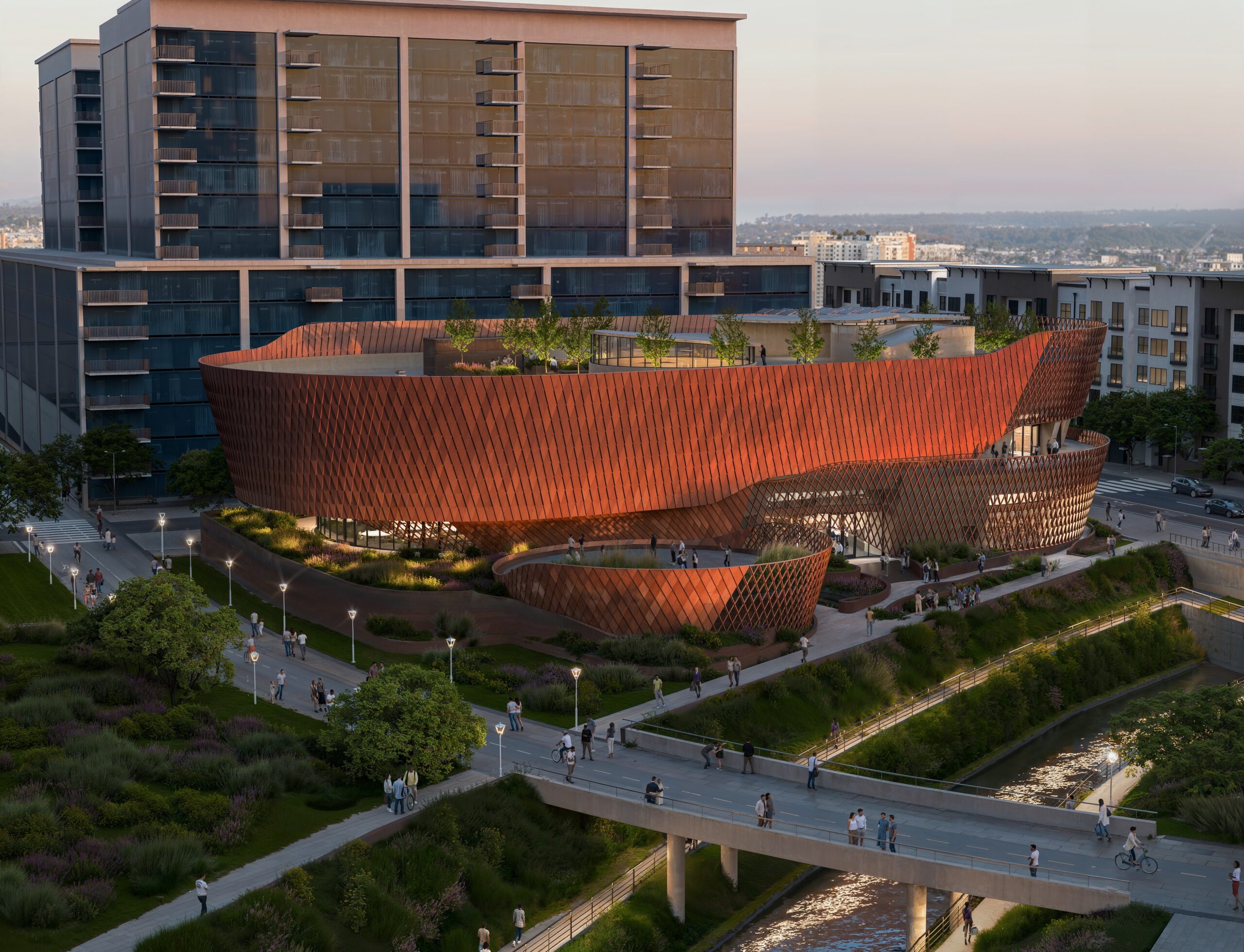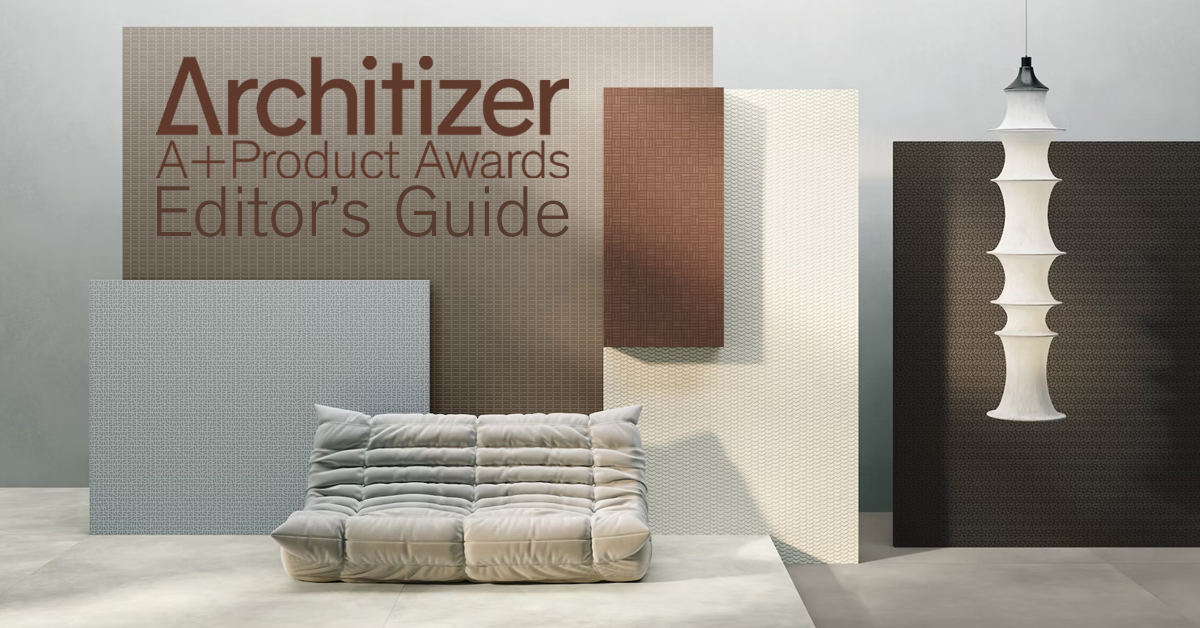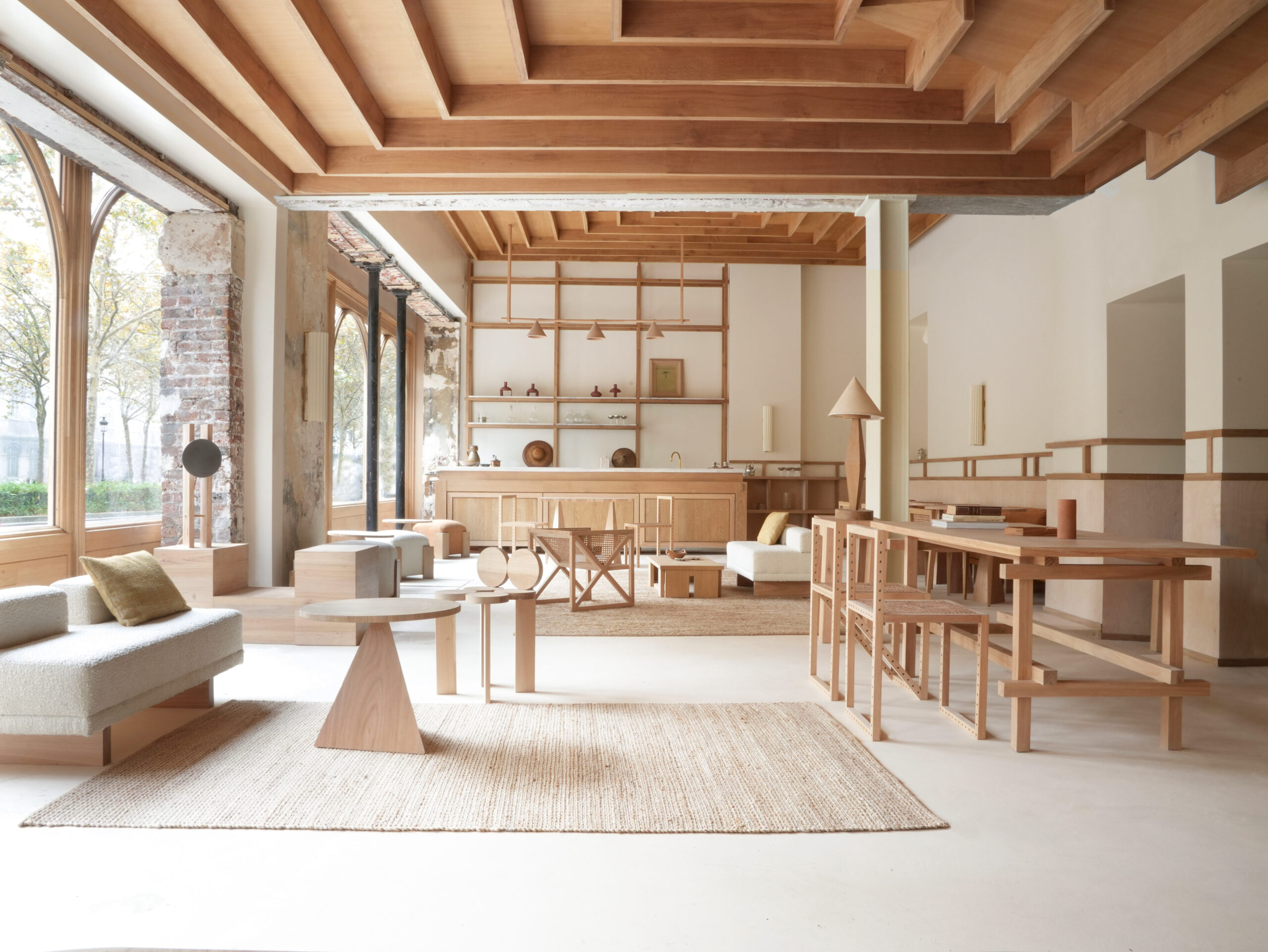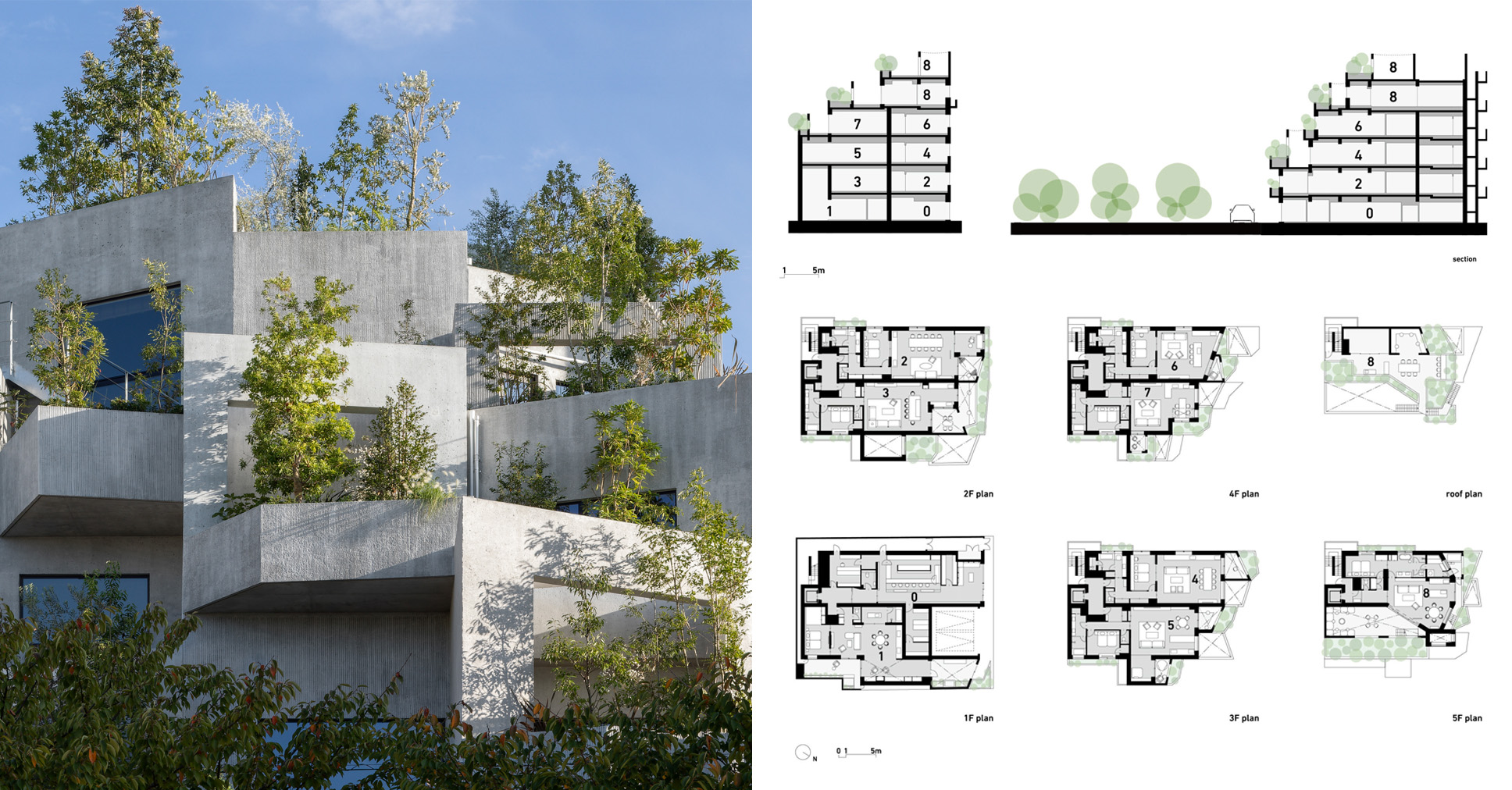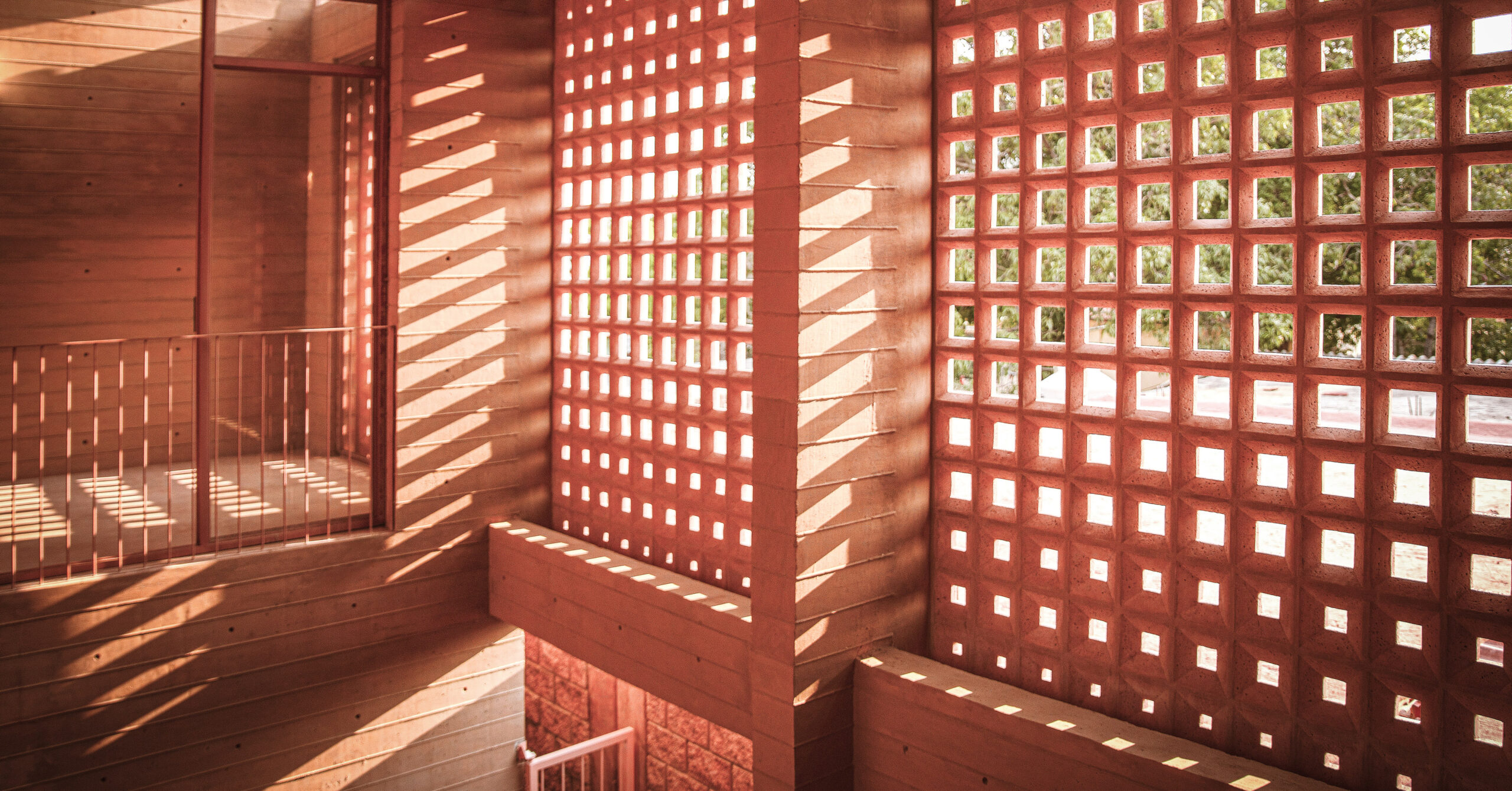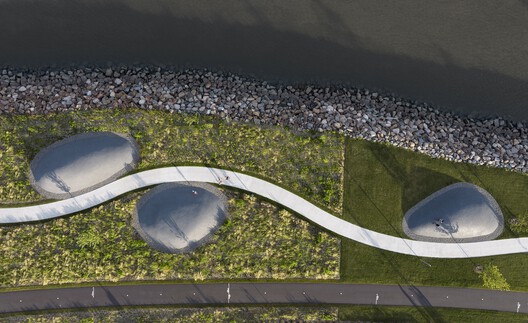Beyond the Balustrade, Balconies Gone Wild: How French Architecture is Expanding Outside
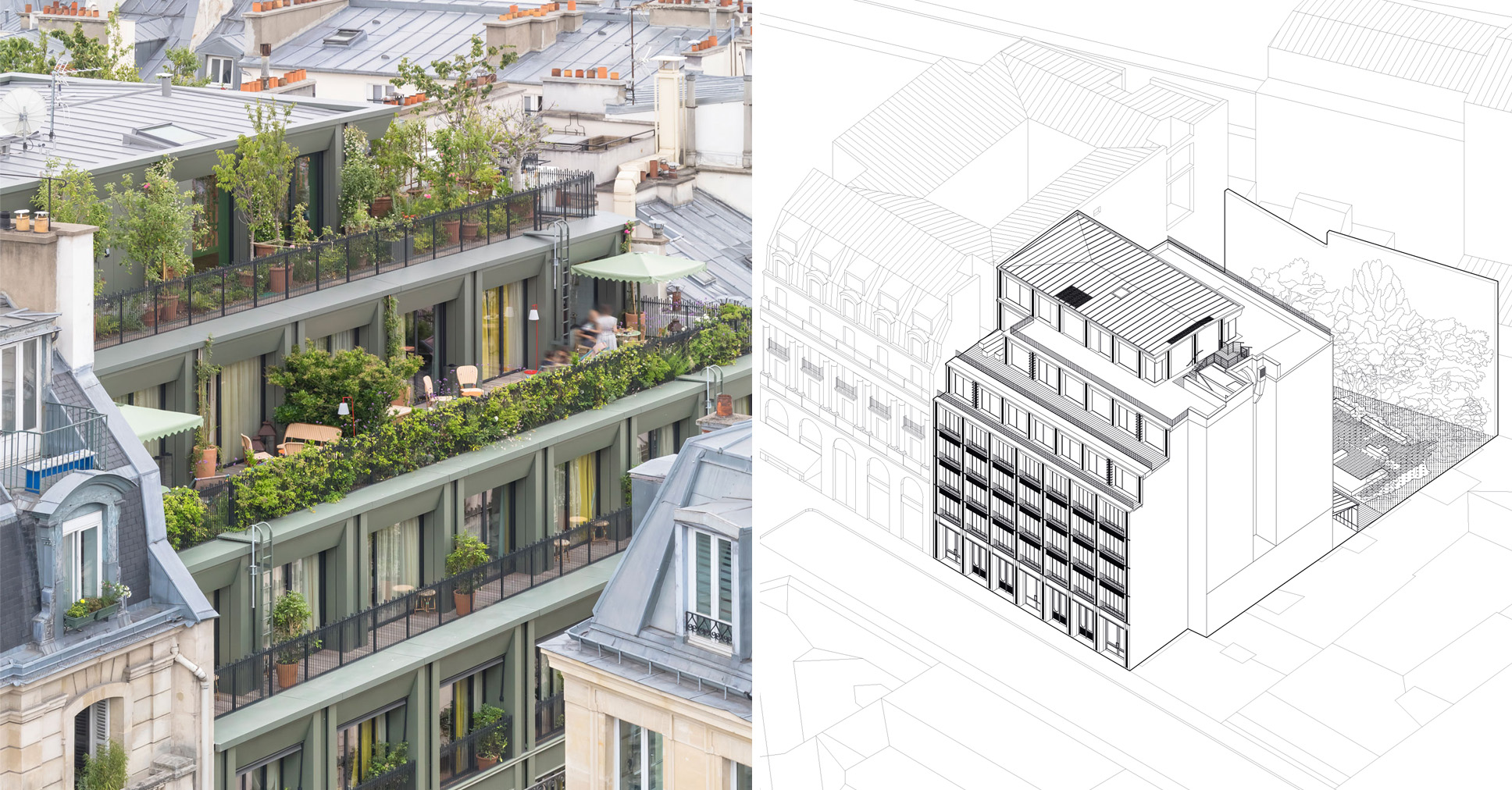
Architects: Want to have your project featured? Showcase your work by uploading projects to Architizer and sign up for our inspirational newsletters.
When one sees the words France and balcony together, a specific image comes to mind: wrought iron railings, a pair of doors that might not open all the way and just enough room to lean out with a coffee or a cigarette (in the true spirit of the French). While we all love the charm of a classic French balcony, France also excels at larger terraces with a real presence and more versatile uses (though some might argue that the original French balcony serves its purpose just fine).
From wide planted platforms and stepped rooftops to deep loggias and layered facades, these outdoor spaces are no longer just decorative. They’re functional, generous and central to the architecture. To capture that shift in scale and intent, this collection features nine projects across the country where terraces shape the building, frame the view and give users room to live beyond the walls.
Emblem
By Hamonic+Masson & Associés, Lille, France
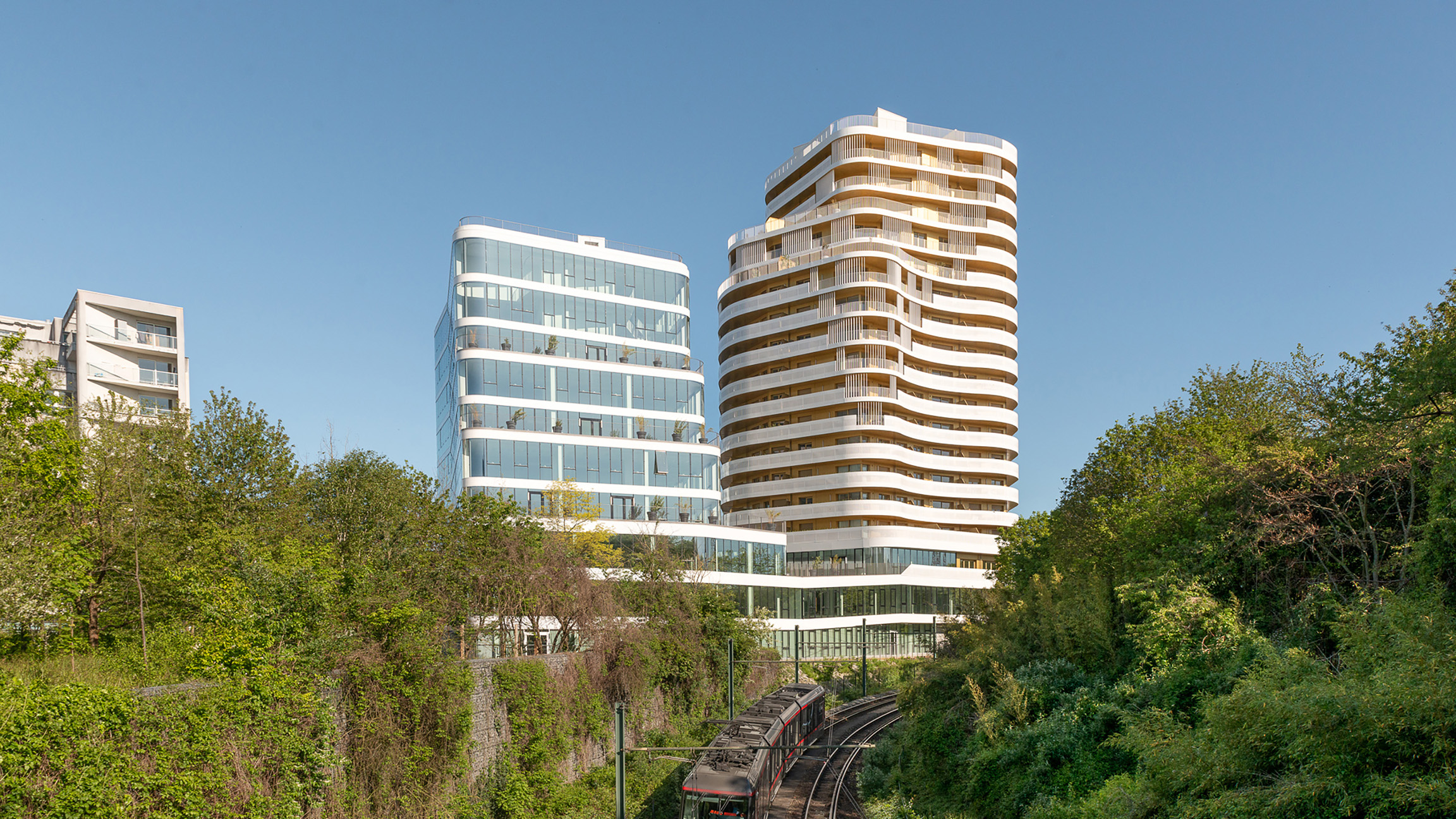
 At the edge of Parc Matisse, Emblem rises between roads, rail lines and the city. The building steps up gradually, starting low near the park and reaching 50 meters at its tallest point. This shift in height brings light into the site and opens up views in every direction. Its most striking feature is the residential tower’s continuous balconies, which wrap the building in curved lines of perforated metal.
At the edge of Parc Matisse, Emblem rises between roads, rail lines and the city. The building steps up gradually, starting low near the park and reaching 50 meters at its tallest point. This shift in height brings light into the site and opens up views in every direction. Its most striking feature is the residential tower’s continuous balconies, which wrap the building in curved lines of perforated metal.
These terraces extend the apartments and provide shade, airflow and outdoor space throughout the tower. The perforated metal screens filter light and add a fine texture to the curved façade. Finished in an earthy tone, the balconies pick up on the colors of the nearby park and local buildings. They shape how the tower is seen from a distance and how it is experienced by the people living inside.
ARBORESCENCE – Winner of Imagine Angers
By WY-TO Group, France
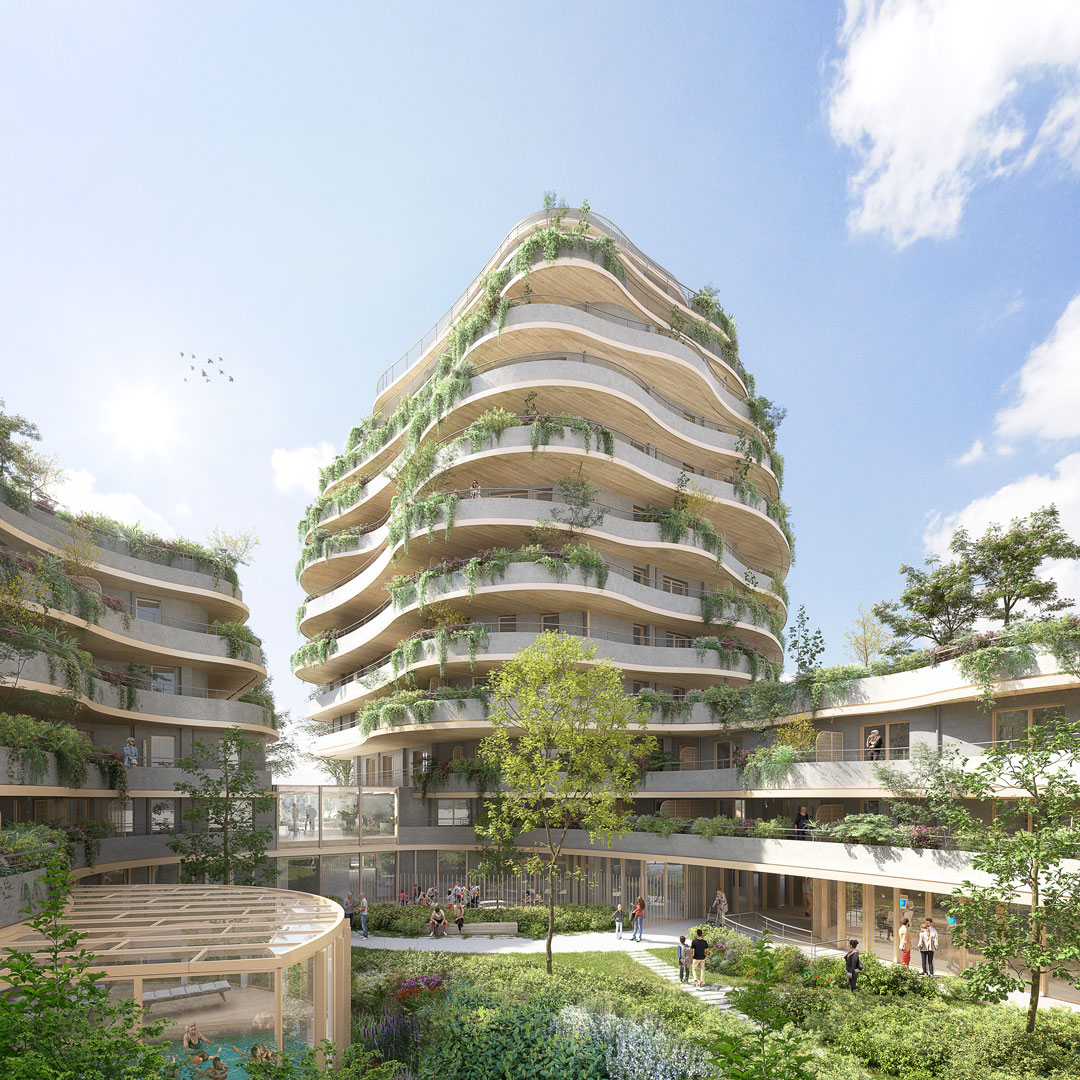
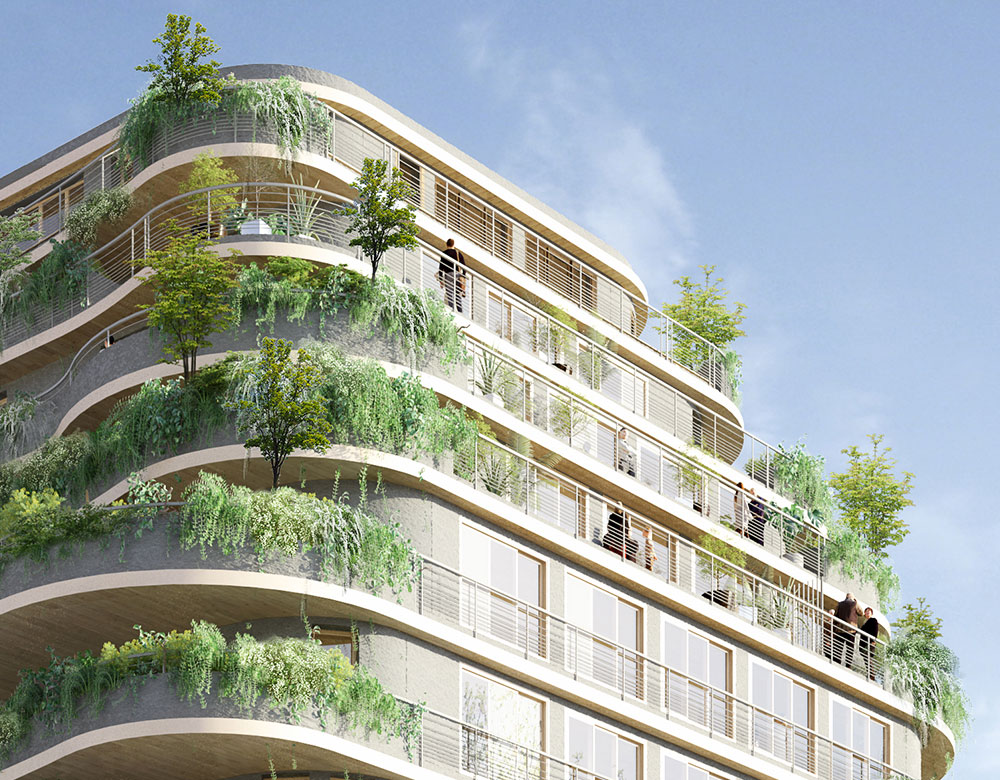 Located between Angers’ historic center and the banks of the Maine, Arborescence introduces a layered design that brings nature into every part of the building. A mix of housing, senior living, childcare and co-working spaces makes it a place for all generations.
Located between Angers’ historic center and the banks of the Maine, Arborescence introduces a layered design that brings nature into every part of the building. A mix of housing, senior living, childcare and co-working spaces makes it a place for all generations.
Terraces define the project’s identity. They shift and grow across the façade like branches, shaped by wind and light. Deep planters and green edges soften the concrete and create privacy without closing residents off from their surroundings. These outdoor spaces add texture and variety, offering different ways to live with the seasons.
The building wraps around a planted courtyard, where shared spaces and gardens bring people together. Every unit opens to light, air and views of the evolving landscape.
Apartments in Illkirch – Graffenstaden
By tectône architectes, France
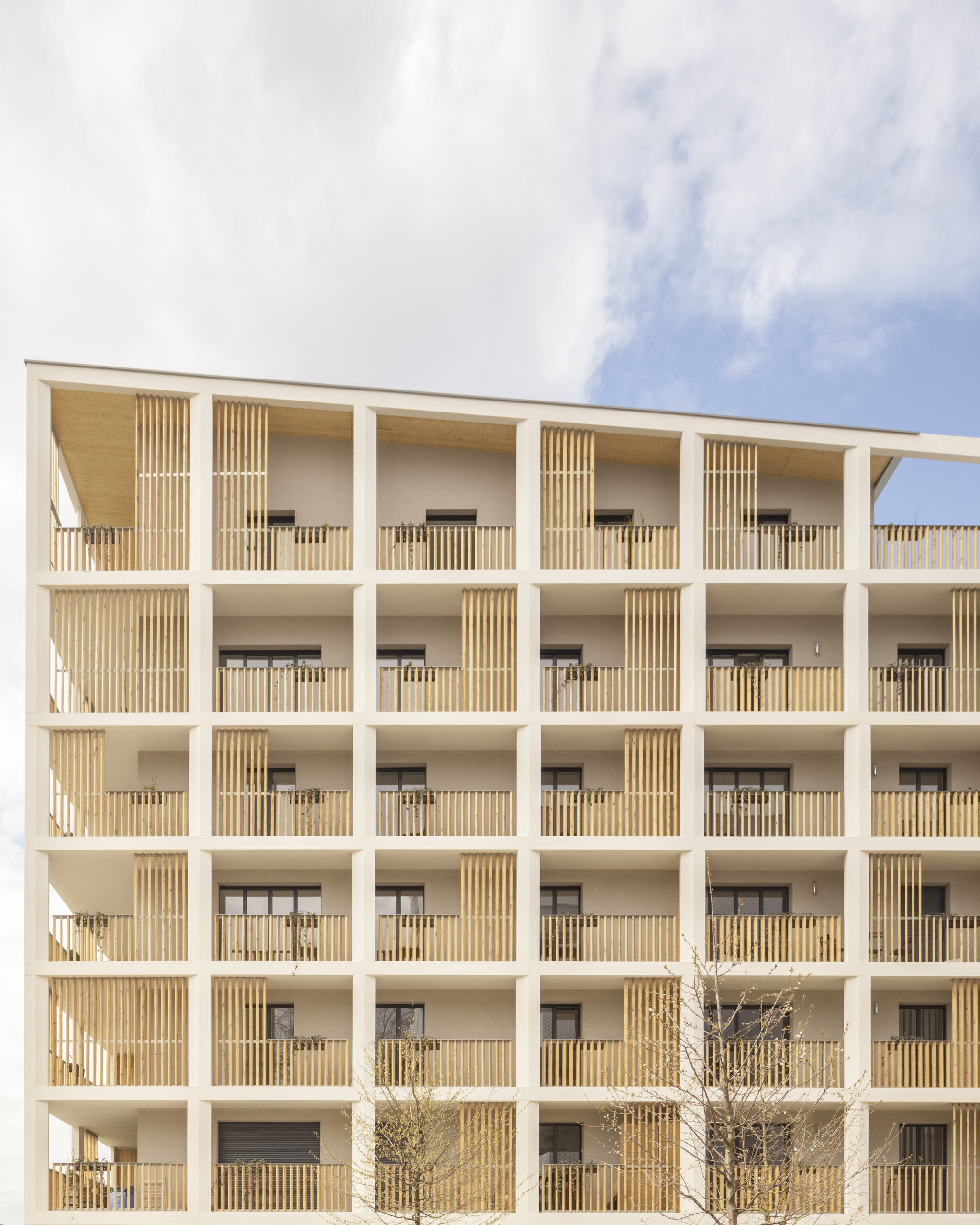 In a car-free woodland near the Rhine-Rhône Canal, this six-story housing project is shaped by its calm setting and careful densification. The structure follows a compact rectangular form, allowing space for gardens and shared areas at ground level.
In a car-free woodland near the Rhine-Rhône Canal, this six-story housing project is shaped by its calm setting and careful densification. The structure follows a compact rectangular form, allowing space for gardens and shared areas at ground level.
Each of the 31 apartments includes a private loggia, framed by a concrete exoskeleton that wraps the entire building. These terraces act as sheltered extensions of the interiors, offering fresh air and outdoor space while preserving privacy. Beveled pillars and wooden guards filter views and sunlight, giving the façade a quiet rhythm. A shared rooftop terrace crowns the building, offering residents a place to meet, relax or enjoy the surrounding trees from above.
L’Arboretum
By Leclercq associés, Nanterre, France
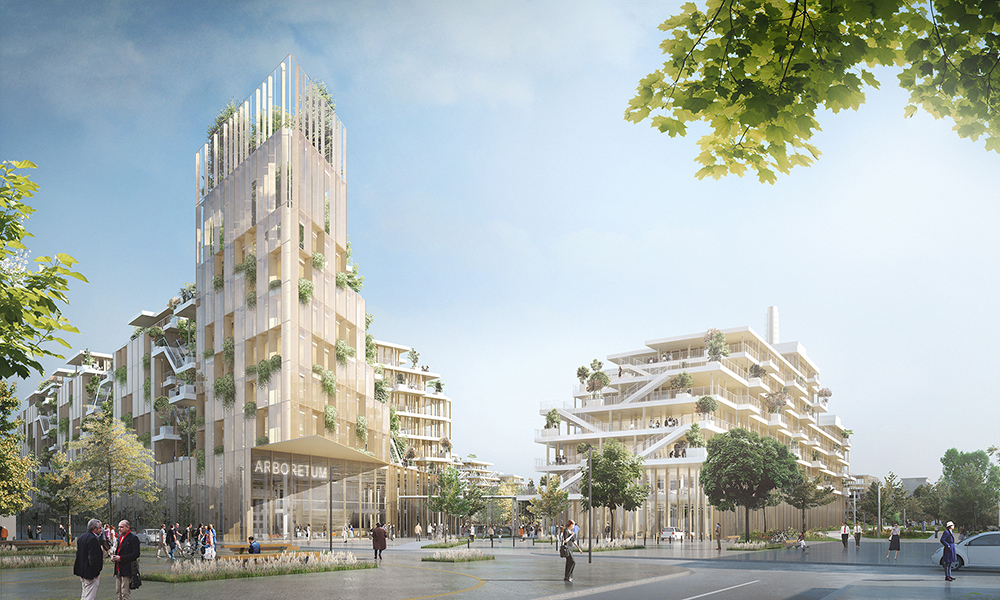
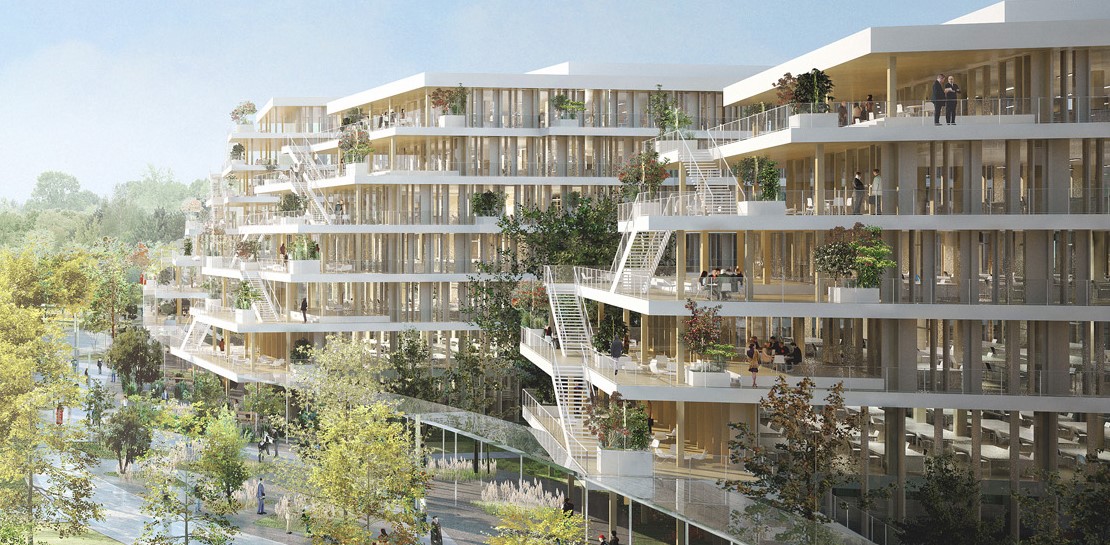 Set along the Seine in Nanterre, Arboretum reimagines the office campus with a focus on sustainability and sensory comfort. Spanning 1355 square feet (126,000 square meters), the complex is built almost entirely from cross-laminated timber and organized around a curved central path that follows the river’s slope.
Set along the Seine in Nanterre, Arboretum reimagines the office campus with a focus on sustainability and sensory comfort. Spanning 1355 square feet (126,000 square meters), the complex is built almost entirely from cross-laminated timber and organized around a curved central path that follows the river’s slope.
Terraces play a key role in the campus design. Every office opens onto outdoor extensions — some for meetings, some for quiet work, others simply for fresh air. These planted spaces vary in size and purpose but all support a connection to the surrounding landscape. The scent of wood, access to light and changing views offer a calmer work rhythm. Together, the terraces and gardens bring nature into the workday without losing sight of the site’s industrial past.
Tale of Transformation La Fantaisie Hotel, Paris
By PETITDIDIERPRIOUX, Paris, France
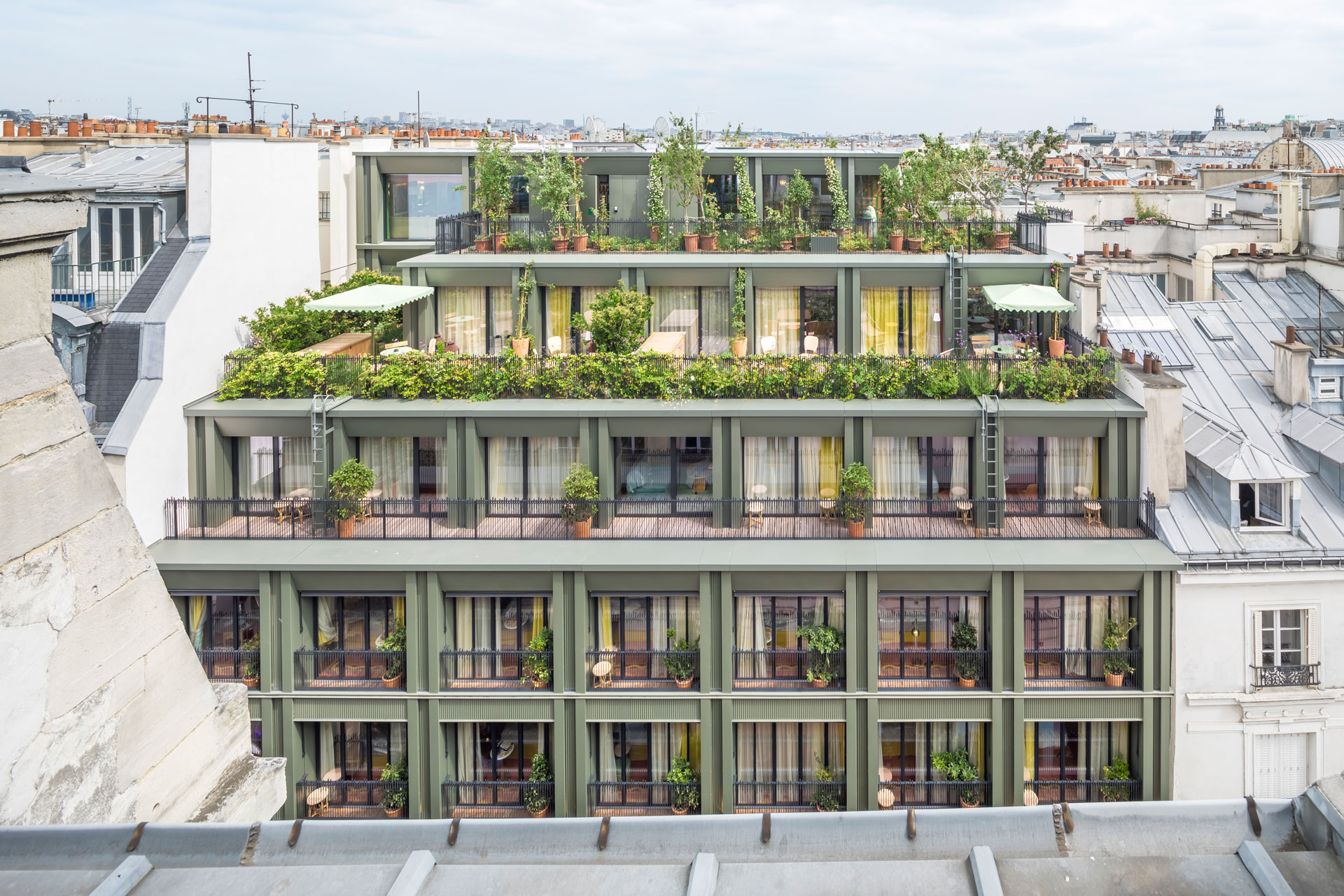
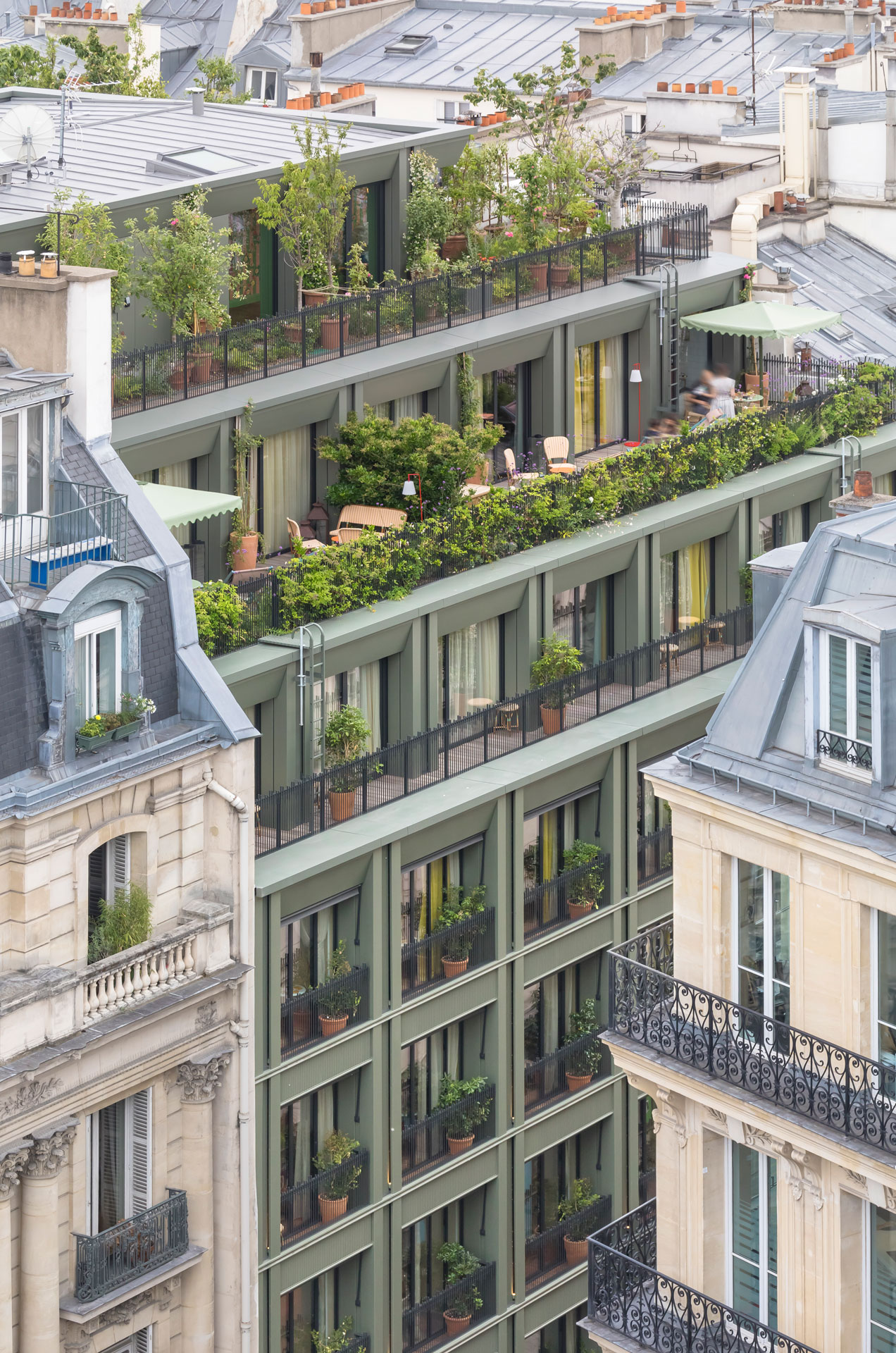 Tucked between dense city blocks in Paris’ 13th arrondissement, Hotel Rosalie transforms a former hotel into a garden-focused retreat. The renovation keeps the original structure while introducing a new façade of pre-patinated zinc that shifts in tone with the light. At the rear, terraces open out toward a reimagined courtyard garden.
Tucked between dense city blocks in Paris’ 13th arrondissement, Hotel Rosalie transforms a former hotel into a garden-focused retreat. The renovation keeps the original structure while introducing a new façade of pre-patinated zinc that shifts in tone with the light. At the rear, terraces open out toward a reimagined courtyard garden.
These outdoor spaces extend the hotel experience beyond the rooms, offering guests a quiet place to pause, read or have a coffee. The terraces connect directly to a ground-level restaurant beneath a wide glass roof, where diners overlook dense plantings that change with the seasons. More than a simple refresh, the project is shaped by a clear goal: to give city guests a reason to slow down and step outside.
Tolbiac Apartments
By Atelier Architecture Vincent Pareiram, Paris, France
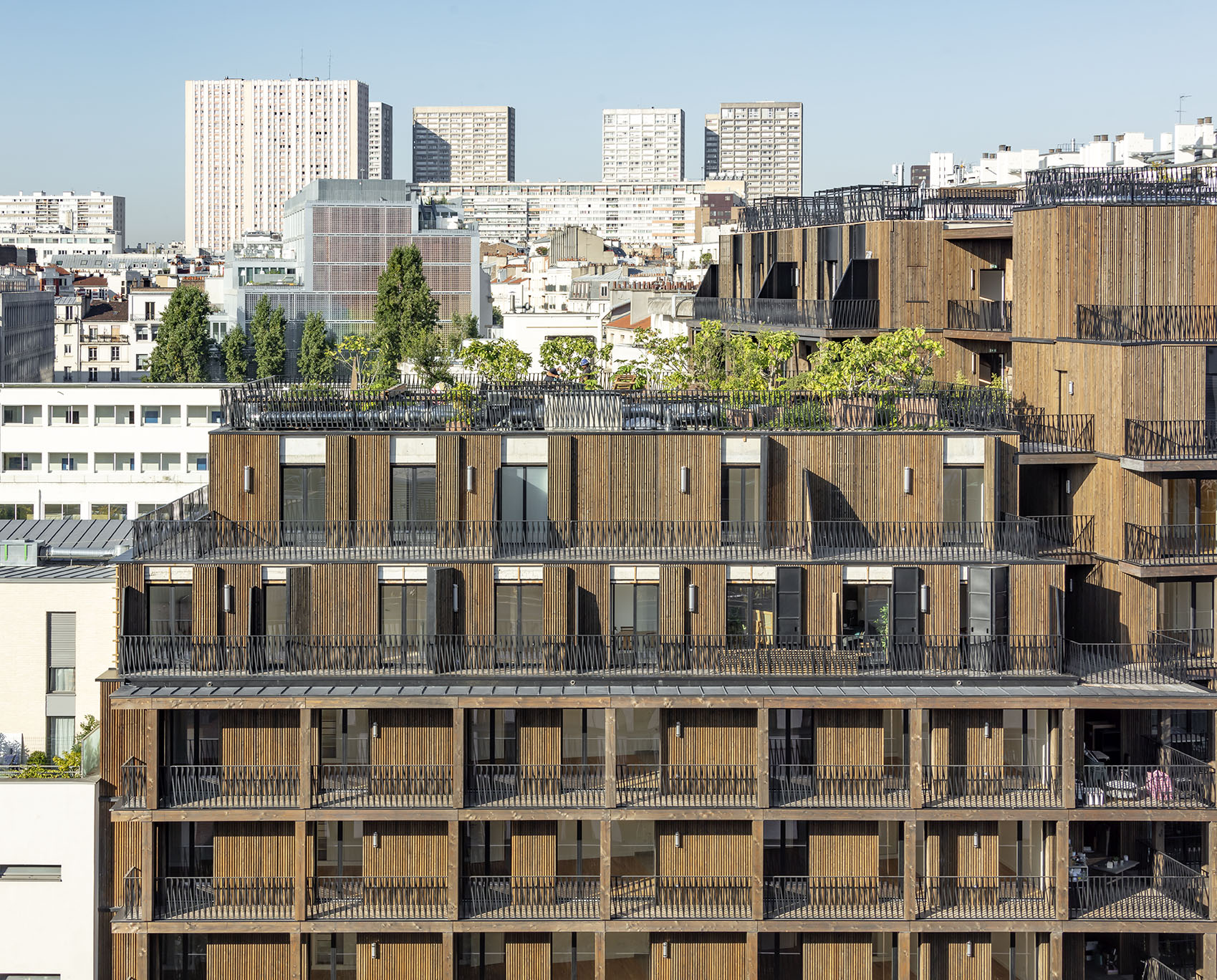
 On a corner site in Paris’ 13th arrondissement, Les Étoffes de Tolbiac builds on the area’s layered history, replacing former workshops with housing, retail and generous outdoor space. The project is shaped by a striking grid of balconies that stretches across three volumes, tying them into a single architectural gesture.
On a corner site in Paris’ 13th arrondissement, Les Étoffes de Tolbiac builds on the area’s layered history, replacing former workshops with housing, retail and generous outdoor space. The project is shaped by a striking grid of balconies that stretches across three volumes, tying them into a single architectural gesture.
These balconies are not just repetitions however as they they shift slightly on each floor, expanding outward as the building rises. This subtle movement increases outdoor space and creates a rhythm that softens the scale of the concrete and timber structure. On the courtyard side, shared terraces and raised walkways link the blocks, offering spaces to gather, rest or look out over the city. A rooftop garden completes the network, giving all residents access to the Paris skyline.
I Park
By NBJ architects, Montpellier, France
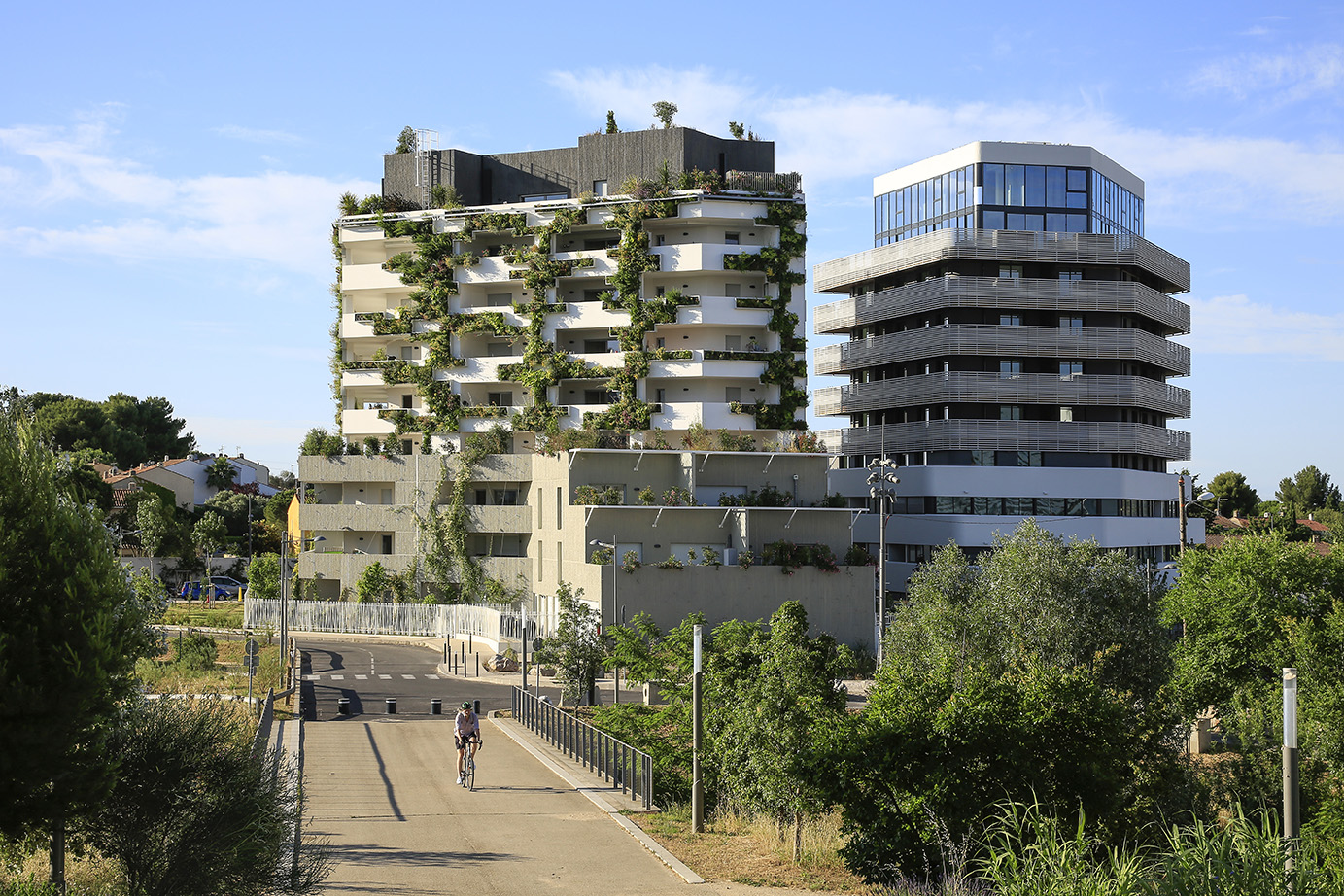
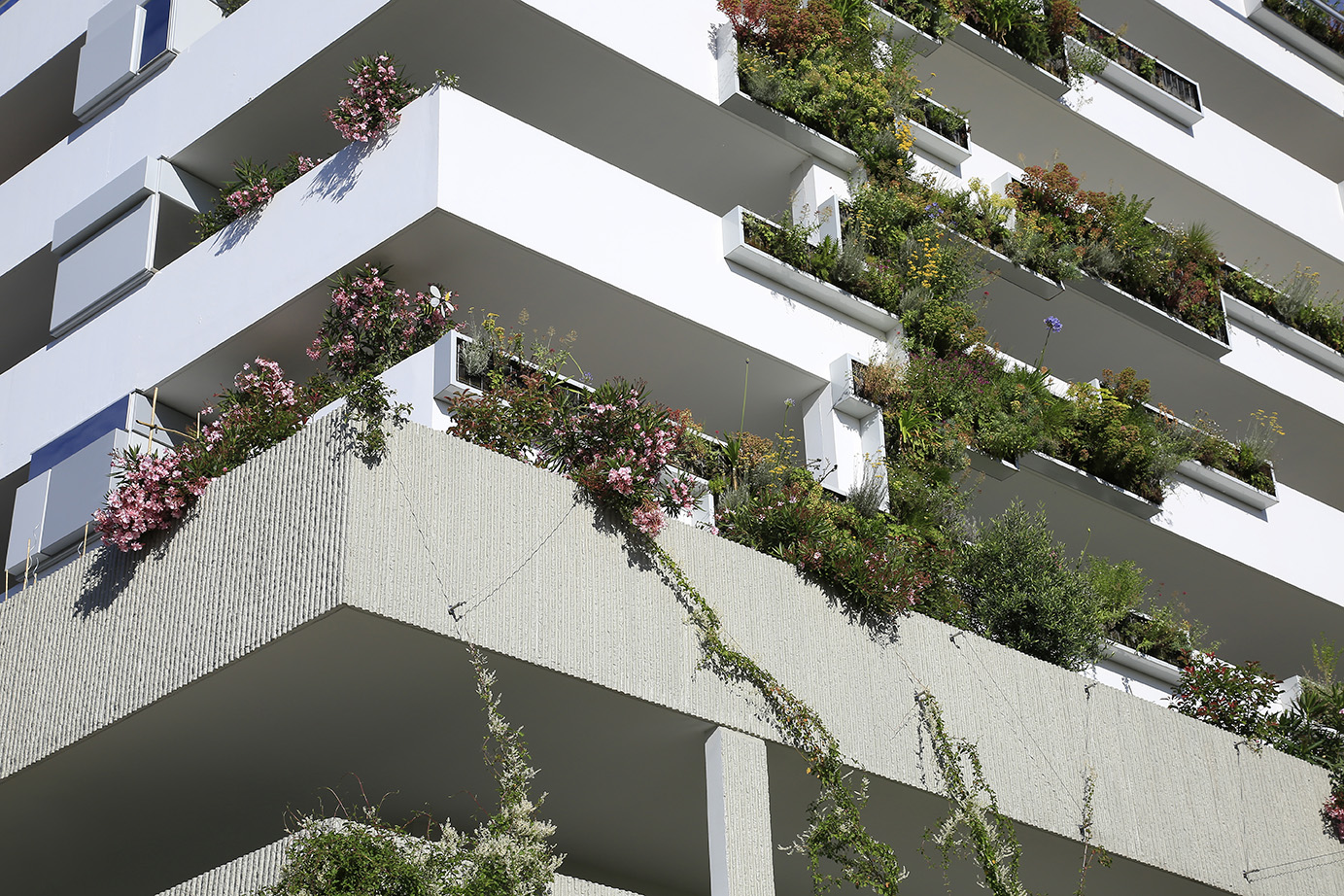 Facing Montpellier’s new city hall, I Park explores how housing can adapt to the Mediterranean climate. The eight-level building is made up of shifting horizontal bands, each one adjusted to optimize shade, airflow and outdoor living.
Facing Montpellier’s new city hall, I Park explores how housing can adapt to the Mediterranean climate. The eight-level building is made up of shifting horizontal bands, each one adjusted to optimize shade, airflow and outdoor living.
Terraces are central to the design. Every apartment opens onto an outdoor space, with planted façades that bring greenery to the edges of each floor. These terraces vary in depth and layout, shaped by solar exposure and wind conditions. The result is a building that reads like a series of stacked gardens.
Designed in close collaboration with local specialists, the project uses vegetation not as decoration, but as an essential part of daily comfort. The terraces make space for both privacy and connection, shaped by climate and site.
Ateliers Vaugirard
By Hamonic+Masson & Associés, Paris, France
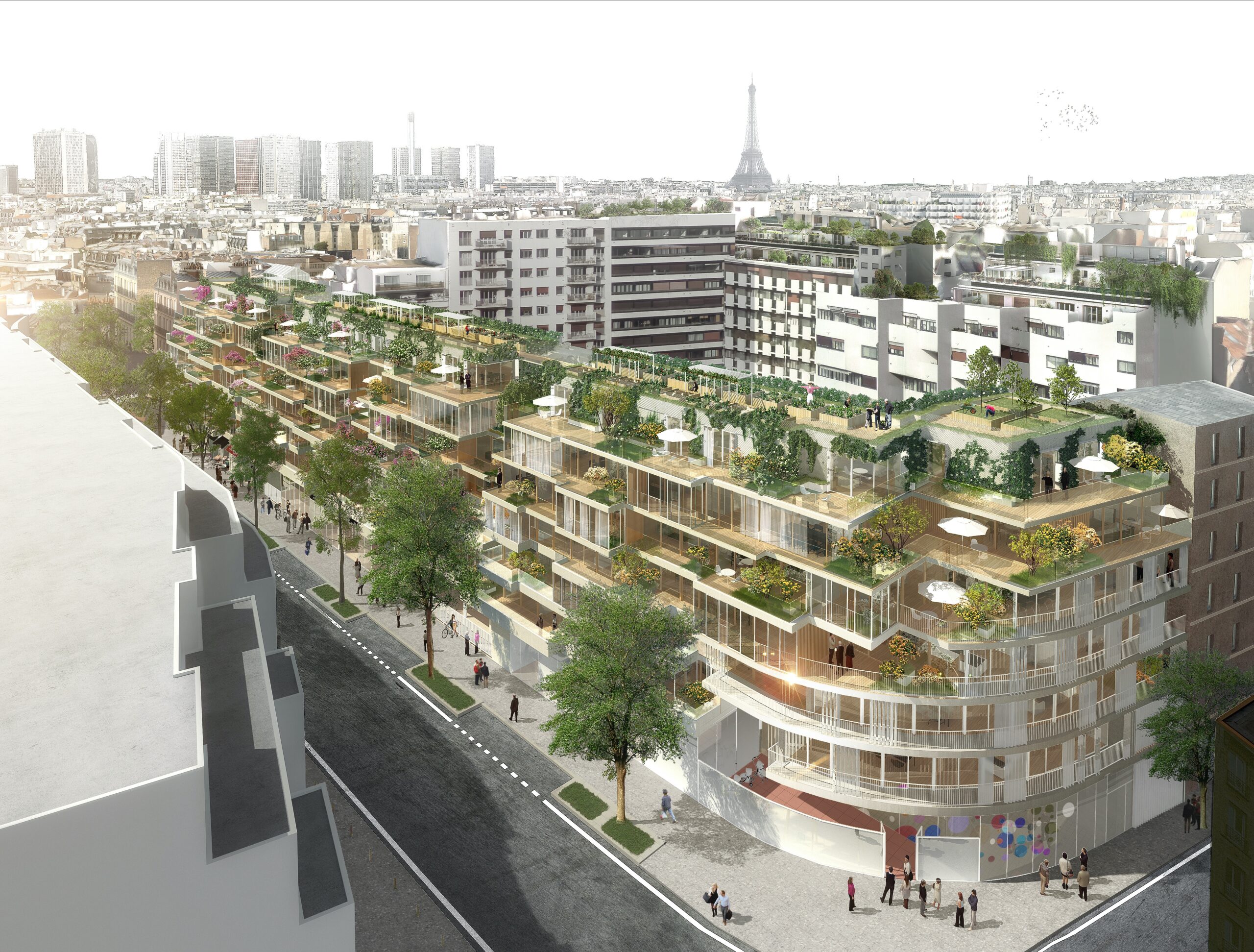 Stretching 425 feet (130 meters) along a busy street, this housing project aims to replace repetition with variety. Ninety-six apartments are divided into 37 distinct layouts, each shaped by a generous terrace or garden. The building’s stepped form opens up views and sunlight, while breaking down the scale of its long volume.
Stretching 425 feet (130 meters) along a busy street, this housing project aims to replace repetition with variety. Ninety-six apartments are divided into 37 distinct layouts, each shaped by a generous terrace or garden. The building’s stepped form opens up views and sunlight, while breaking down the scale of its long volume.
Terraces are wide and deep, averaging 215 square feet (20 square meters) per unit. These outdoor spaces give residents room to grow plants, eat outside, or simply pause between indoors and out. The planted terraces also act as visual filters, softening views between neighbors and creating a layered edge to the street. Above, the skyline rises and dips. On the ground, shops and public paths invite life to spill into and around the building.
BEAUPASSAGE
By Franklin Azzi Architecture, Paris, France
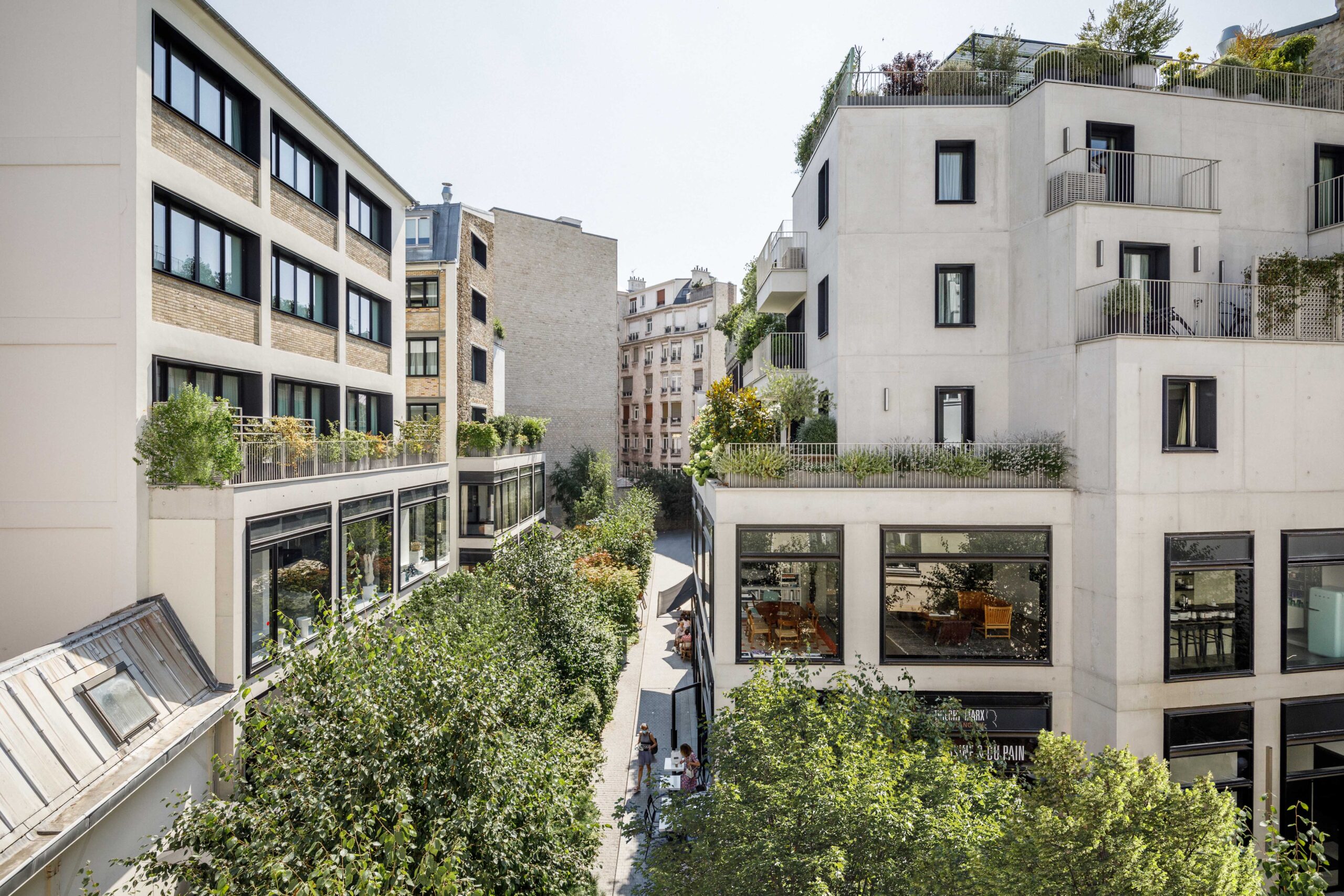
 In Paris’ 7th arrondissement, a formerly hidden industrial block is carefully brought back to life through a mix of rehabilitation and new construction. Franklin Azzi’s design respects the site’s patchwork of buildings, preserving historic façades and structures while introducing modern uses.
In Paris’ 7th arrondissement, a formerly hidden industrial block is carefully brought back to life through a mix of rehabilitation and new construction. Franklin Azzi’s design respects the site’s patchwork of buildings, preserving historic façades and structures while introducing modern uses.
Terraces are carved into the architecture with precision. Inserted between existing frames and new additions, they act as quiet thresholds between the homes and the city. These outdoor spaces vary in scale, responding to the irregular geometry of the site. Some open to shared courtyards, others are tucked above street level, catching light where it falls.
The project stays close to the original materials and proportions, using terraces to invite daily life into a place long kept out of view.
Architects: Want to have your project featured? Showcase your work by uploading projects to Architizer and sign up for our inspirational newsletters.
The post Beyond the Balustrade, Balconies Gone Wild: How French Architecture is Expanding Outside appeared first on Journal.
